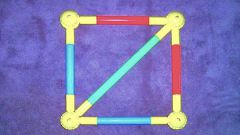Instruction
1
diagonal/em/b" class="colorbox imagefield imagefield-imagelink" rel="gallery-step-images"> Rectangular quadrilaterals (rectangle, square) the diagonal divides into two right-angled triangles, in each of which she will be the hypotenuse. Therefore, for calculating it is possible to use the Pythagorean theorem. a2=b2+c2, where a is the hypotenuse, b and C are the legs. Example 1: find the diagonal AC , if you know that length BC=3 cm, AB=5 cm Solution: calculate the hypotenuse AC in right triangle ABC. AC2=AB2+BC2; AC2=52+32=34; from this value, extract the square root of a: AC=√34=5.8 to see the Answer: the diagonal of the rectangle is equal to 5.8 cm
2
If you see a square, then calculate the diagonal is possible, knowing one of its sides or the square. Since all the sides of the square are equal, the Pythagorean theorem is: a2=b2+b2, a2=2b2. Square - the product of two sides (S=b2). Hence, the square of the hypotenuse (in the figure the square) equal to twice the area (a2=2S).Example 2: the area of a square is 16 cm2. Find the length of the diagonal. Solution: calculate the length of the diagonal and through the area. a2=2S, a2=2*16 cm2=32; extract the square root a=√32≈5.7 cm answer: the length of the diagonal of the square – 5.7 cm
3
In some cases, to compute the diagonals necessary to make additional construction.Example 3: an equilateral polygon with sides equal to 6 cm, angle BCD straight. Find the length of diagonal AB.Solution: connect points B and D. it Turned out a right triangle BCD in which side BD is the hypotenuse. Calculate the hypotenuse BD: BD2=BC+CD2; BD2=62+62=72; the Hypotenuse BD of the triangle BCD is the leg of the triangle ABD. And the diagonal AB is the hypotenuse in it. Calculate diagonal AB: AB2=BD2+AD2=72+36=108; AB=√108=10,4 cm a: length of diagonal AB=10,4 cm
4
The diagonal of a cube can be found using the diagonal of one of its faces.Example 4: a cube with side 5 cm Find the diagonal of the cube.Solution: extend and calculate the diagonal of the cube face. AC2=52+52=50. The diagonal AC is perpendicular to the edge of the CB, therefore the angle ACB is a straight line. Diagonal cube AB is the hypotenuse of the triangle ACB. Find the length of diagonal of cube: AB2=AC2+CB2=50+25=75; extract the square root. AB=√75=8,7 cm answer: the length of the diagonal of a cube is 8.7 cm
5
To calculate the diagonals of a parallelogram using the theorem of cosines: c2=a2+b2-2ab*cosy.Example 5: a = 2 cm b = 3 cm, γ = 120°. Find the diagonal of s. Solution: substitute the values into the formula. c2= 22+32-2*2*3*cos120°; cos120° look at the table of cosines at (-0.5). S2 = 4+9-12*(-0,5)=13-(-6)=19. From this value, extract the root: C = √19 = 4,35 see Answer: length of diagonal = 4,35 cm



